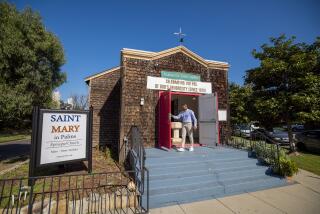Crenshaw-area housing for seniors exemplifies the AME Church’s civic-minded brand of faith
Social engagement and economic development have been cornerstones of the African Methodist Episcopal Church since it was founded in the late 1700s by black congregants who refused to move to the back of a white church in Philadelphia to pray.
In one of the first civil rights protests in American history, they crossed the street to worship inside a blacksmith shop, where an anvil served as an altar and pulpit. The AME church went on to fight against slavery and prejudice, found colleges and seminaries and support development of community improvement projects across the country. Today, it has more than 2 million members.
One of the latest examples of the church’s dedication to a civic-minded brand of Christianity is a new 60-unit housing development for low-income seniors, which dominates a hill overlooking the 10 Freeway and Crenshaw Boulevard in South Los Angeles.
The $17-million development, Rosa Parks Villas, was built by Ward Economic Development Corp., an independent, nonprofit affiliate of nearby Ward African Methodist Episcopal Church. It is part of the Los Angeles Community Redevelopment Agency’s Crenshaw Gateway, a large-scale project designed to attract new retail and residential development along Crenshaw Boulevard between the freeway and Adams Boulevard.
“Some feel a church’s mission is to preach the Bible, and that’s fine,” said Ward AME Pastor C. Dennis Williams. “But once we’ve delivered people from sin, we have to try to establish adequate housing for them.
“In that spirit,” he said, “the monument we have established is an example of our continuing efforts to provide rights and decent living conditions for people of all complexions. It is also a reminder that the struggle is not over.”
During a recent tour of the center, Jacquelyn Dupont-Walker, president of Ward Economic Development Corp., noted what she called the project’s “remarkable history.”
In 1964, a group of black activists with money and social cachet wanted to develop a hotel on the site in Sugar Hill, a middle-class African American neighborhood that had been devastated by construction of the Santa Monica freeway.
Among them were civil rights attorney Leo Branton Jr., who owned the land, and entertainer Nat King Cole. But the project, which they hoped would revitalize the local economy, fell apart after Cole’s death in 1965.
Over the next 45 years, the parcel served mainly as a prime location for displaying campaign signs.
Ward Economic Development Corp. bought the property in 2005, Dupont-Walker said. “After that, it took five years of rubbing nickels and dimes together in tough economic times to get this job done. We had to break through a mind-set that the area just wasn’t worth investing in.”
Whenever she got discouraged, Dupont-Walker, who is also a member of the church’s social action committee, said she turned to the “nature and mission of the church” section of the AME Book of Discipline.
It says, in part: “The AME Church must fully identify with the poor and the oppressed in their struggle for human dignity.... This participation in human development is not optional, nor is it an addendum to an already crowded agenda. It must be at the very heart and the life and work of our church.”
She said she also found solace in Isaiah 61:4: “They shall repair the ruined cities and restore what has long lain desolate.”
Along with the new senior center, the area is slated for improvements that include a $1.4-billion Crenshaw light-rail transit line to link the area to a station near Los Angeles International Airport and a $93-million retail project aimed at revitalizing the Crenshaw corridor.
Los Angeles Councilman Herb Wesson, who represents the neighborhood, attended the center’s dedication and called it a first step.
“We are already experiencing a demographic shift that is creating a new and solid middle-class population of white folks, Asians, Latinos and African Americans,” Wesson said. “Some home values are up to $1 million, and business people are realizing that this community is starving for development.”
In an effort to revitalize the area, a group of Ward AME congregants in 1985 began researching church building programs elsewhere, such as at Bethel AME in Baltimore and Allen AME in Queens, N.Y.
Two years later, the group launched its economic development corporation. In its first venture, the nonprofit arranged financing and construction of the 120-unit Ward Villas, a senior housing project in South Los Angeles.
An honored guest at that project’s opening ceremonies was Rosa Parks, a lifelong AME church member who helped launch the modern civil rights movement in 1955, when she refused to give up her seat to a white passenger on a segregated bus in Montgomery, Ala.
Parks, who wintered in Southern California as a guest of Branton, was also an advocate of affordable housing projects promoted by churches.
“Ward AME is to be commended because it has been true to that legacy,” said the Rev. Cecil “Chip” Murray, 81, the retired pastor of First AME Church of Los Angeles, one of the nation’s most prominent African American churches.
Branton, 88, agreed. In a telephone interview, he chuckled and said, “I like to think Nat King Cole and Rosa Parks are looking down on this project from on high and beaming because people are still carrying on the good work and the dream didn’t die.”



